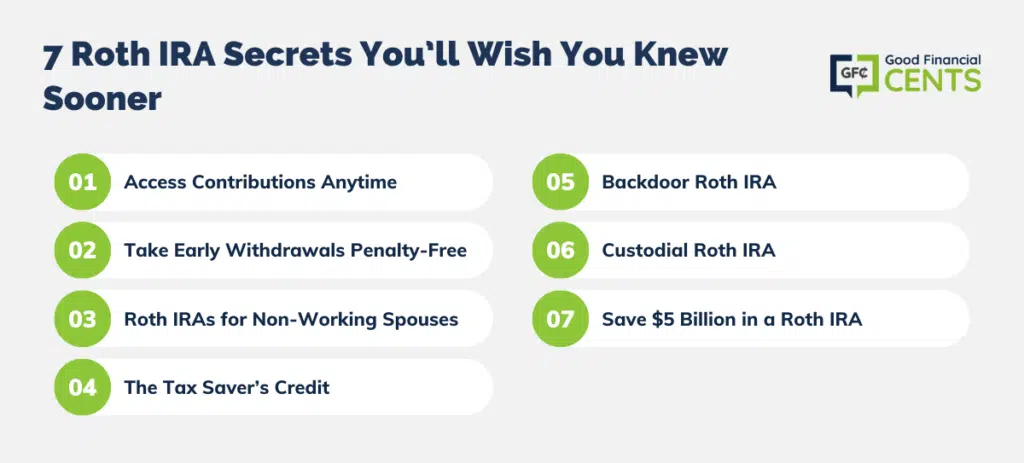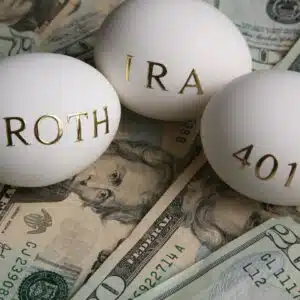The Roth IRA is a popular retirement account, and it’s incredibly easy to see why. Yes, you have to invest in this account with after-tax dollars, but your money grows tax-free and you don’t have to pay income taxes later on.
In case you missed that:
You can also open a Roth IRA with any major brokerage firm with ease, and you can contribute up to $7,000 per year in 2025 if you meet income requirements (or $8,000 per year if you’re aged 50 or older).
The thing is, there are some hidden features of Roth IRAs that you may not even know about, including secrets that can help you build a portfolio of up to $5 billion in this type of account.
What are the biggest Roth IRA secrets? Read all the way to the bottom to find out.
Table of Contents
#1: Access Contributions Anytime
First off, did you know that you don’t have to wait until age 59 ½ to access funds in your Roth IRA?
With a Roth IRA, you can take out contributions at any time without having to pay a penalty. This means you can take out whatever you have put in over the years, but you typically have to leave any earnings in your account for continued growth.
This feature of the Roth IRA comes into play since you put in after-tax money to begin with. By and large, this gives you the ability to pull that money out for any reason, whether you need to pay off medical bills or you want to remodel your kitchen. If you invest the Roth IRA contribution limit of $7,000 per year for five years, you can take out $35,000 after that timeline without having to pay a dime in penalties and fees.
#2 Take Early Withdrawals Penalty-Free
While IRA stands for “individual retirement account,” you don’t necessarily have to use the funds for retirement. In fact, there are several strategies you can use to access your Roth IRA contributions and earnings without having to pay the 10% tax penalty you would normally face.
How and why does this work? When you dig around a little, you’ll find that the IRS has some special language in the tax code that allows you to pull out earnings from your Roth IRA without any fees in certain situations. Specifically, you can use this money if you need to pay for higher education expenses or come up with a down payment for your first home.
Other exceptions you can qualify for include death, disability, certain medical expenses, and more.
Want to see me talk about Roth IRA secrets in the flesh? Check out my latest video for my Wealth Hacker YouTube channel:
#3: Roth IRAs for Non-Working Spouses
While most people need earned income for retirement, the Roth IRA has a third secret that comes into play here.
Are you ready for this?
Your spouse can also have a Roth IRA — even if they don’t have a traditional job.
This is commonly referred to as a spousal Roth IRA.
For this strategy to work, the IRS only requires that you earn enough so that both of you can contribute. You also have to come in under the income limits set by the IRS for Roth IRA contributions.
In 2025, for example, couples who are married filing jointly have to have a MAGI of less than $230,000 to contribute the full amount. For incomes that fall between $230,000 and $240,000, contributions are phased out, and couples who earn more than that cannot contribute to a Roth IRA at all.
#4: The Tax Saver’s Credit
While Roth IRAs are known for their after-tax contributions and tax-free growth, it’s actually possible to get a credit for money you put into this account. In fact, the Tax Saver’s Credit lets you enjoy upfront tax savings of up to 50% of your contribution, although you can’t earn very much and still qualify.
In fact, married couples filing jointly can qualify for a Tax Saver’s Credit of 10% if they earn between $47,501 and $73,000. Meanwhile, those who earn between $43,501 and $47,500 can qualify for a 20% credit.
If you’re curious where your tax credit could fall based on your own income, this resource on the IRS website can help you find out.
#5: Backdoor Roth IRA
If you earn too much money to save with a Roth IRA, there’s another important secret you should know about — the backdoor Roth IRA. This move became an option back in 2011 when the IRS made an important adjustment to Roth IRA rules. Note: The backdoor Roth IRA is also referred to as a Roth IRA conversation.
Here’s how the backdoor Roth IRA works: Instead of putting money directly into a Roth IRA, you first start putting it into a traditional IRA, or a non-deductible IRA. Once the money is in there, you do a Roth IRA conversion, converting the funds into a Roth IRA.
That might sound really simple, and it is, but there is a catch. You have to pay taxes on the amount you convert. This means Roth conversions usually work best in years when your tax rate is on the lower side.
With that in mind, you’ll want to approach the backdoor Roth IRA with care. If you’re thinking about taking advantage of the secret, I would highly suggest you meet with your CPA or a tax professional to see if this makes sense.
#6: Custodial Roth IRA
For those who have kids or plan on having kids one day, you’re going to love this secret. This includes me; after all, I have four children ages 14, 11, 10, and seven. Even though all of them are minors, they all have their own Roth IRA.
Here’s how this works: For the most part, you have to be at least 18 years old and have reportable income to have a Roth IRA (unless you’re using a spousal IRA, which we talked about earlier). However, the IRS offers exceptions for the custodial Roth IRA, which lets parents set up this account for their dependent children.
With a custodial Roth IRA, you are in charge of the money in the account until your children become legal adults. With that being said, your kid has to have real income that is reported to the IRS — not just cash from babysitting or mowing lawns. We made this work for my family because I’m a small business owner with an online business.
I do a lot of brand deals and sponsorship deals, and my kids are frequently included in various campaigns I work on. Talking with my CPA, it only made sense to add our children to our payroll.
If your child has any reportable income, whether you are the one employing them or not, you can use this secret to help them build long-term wealth. And with the power of time and compound interest on their side, this tip can pay off for your kids in a big way.
#7: Save $5 Billion in a Roth IRA
Are you ready to hear how someone can build up a $5 billion dollars Roth IRA? Get ready for this one.
First of all, it’s important to know that the Roth IRA lets you invest in alternatives other than just stocks. In the case of the $5 billion Roth IRA, we’re talking about an investor named Peter Thiel, who is the co-founder of PayPal. Thiel was also the first outside investor in Facebook, so I’m sure you can imagine how much wealth he was able to build.
In Peter’s case, he was able to invest in PayPal before anybody knew who PayPal was, and when the price per share was only $0.001 cents. Thiel was able to buy 1.7 million shares of PayPal back in the day using $2,000 of his Roth IRA funds. That PayPal stock is now worth over $5 billion and it’s tax-free.
You may not have access to a stock before it goes IPO like Thiel did, but there are other investments that you can place inside your Roth IRA. For example, you could put real estate, cryptocurrency, or private businesses in your Roth. The only catch is, you have to find a custodian that is willing to hold these types of assets.
So, if you’re opening a Roth IRA at Fidelity, Vanguard, or Edward Jones, there is no way they’re going to allow you to hold these types of assets. You’ll need to look at third-party custodians who will set up a Roth IRA for you and hold alternate investments, which is how Thiel pulled off this crazy feat.
Also, check out my latest podcast on Roth IRA secrets you’ll wish you knew!

The Bottom Line – 7 Roth IRA Secrets You’ll Wish You Knew Sooner
The Roth IRA is extremely powerful when it comes to saving for retirement, and that’s true whether you know about these secrets or not. You do have to invest after-tax money, so there are no tax benefits upfront. However, having tax-free income in retirement can be a huge blessing — especially if tax rates increase dramatically in the future.
If you’re considering a Roth IRA, you can open this account with an array of firms from Vanguard to M1 Finance and TD Ameritrade. Make sure to compare all your options, but don’t delay opening a Roth IRA if you don’t have this account yet. Trust me — your future self will thank you.







